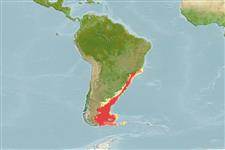>
Gadiformes (Cods) >
Merlucciidae (Merluccid hakes)
Etymology: Merluccius: Latin, mar, maris = the sea + Latin, lucius = pike (Ref. 45335).
Eponymy: Professor Carl Levitt (Leavitt) Hubbs (1894–1979) was a giant of American ichthyology. [...] (Ref. 128868), visit book page.
Environment: milieu / climate zone / depth range / distribution range
Ecologia
marinhas bentopelágico; oceanódromo (Ref. 51243); intervalo de profundidade 50 - 800 m (Ref. 9715), usually 100 - 200 m (Ref. 1371). Temperate; 20°S - 56°S, 69°W - 40°W (Ref. 58452)
Southwest Atlantic: off southern Brazil to Argentina and the Falkland Islands up to 54°S (Ref. 47377).
Length at first maturity / Tamanho / Peso / Idade
Maturity: Lm 30.4 range ? - ? cm
Max length : 95.0 cm TL macho/indeterminado; (Ref. 1371); common length : 50.0 cm TL macho/indeterminado; (Ref. 1371); common length :60 cm TL (female); Idade máx. registada: 6 anos (Ref. 83871)
Espinhos dorsais (total) : 1; Raios dorsais moles (total) : 43 - 52; Espinhos anais: 0; Raios anais moles: 36 - 41; Vértebras: 50 - 53. Gill rakers short and thick with blunt tips. Pectoral fins relatively short, not reaching level of anal fin origin. Color is silvery with golden luster on back, silvery white on belly (Ref. 1371).
Adults inhabit continental shelf depths mainly between 100 and 200 m (Ref. 1371). Larger individuals feed on fish (anchovies, hake, nototheniids, myctophids and Southern blue whitings), squids and macrozooplankton (euphausiids and amphipods); smaller individuals feed on mysids and amphipods (Ref. 1371). Migrate inshore during spring and summer, and offshore into deep water wintering areas after spawning; also undertake diel vertical migrations (Ref. 1371). Sold fresh and frozen.
An indeterminate batch spawner.
Cohen, D.M., T. Inada, T. Iwamoto and N. Scialabba, 1990. FAO species catalogue. Vol. 10. Gadiform fishes of the world (Order Gadiformes). An annotated and illustrated catalogue of cods, hakes, grenadiers and other gadiform fishes known to date. FAO Fish. Synop. 125(10). Rome: FAO. 442 p. (Ref. 1371)
Categoria na Lista Vermelha da IUCN (Ref. 130435: Version 2024-1)
Ameaça para o homem
Harmless
Utilização humana
Pescarias: altamente comercial; peixe desportivo: sim
Ferramentas
Relatórios especiais
Descarregue XML
Fontes da internet
Estimates based on models
Preferred temperature (Ref.
123201): 4.5 - 18, mean 6.3 °C (based on 214 cells).
Phylogenetic diversity index (Ref.
82804): PD
50 = 0.5000 [Uniqueness, from 0.5 = low to 2.0 = high].
Bayesian length-weight: a=0.00479 (0.00402 - 0.00570), b=3.10 (3.05 - 3.15), in cm total length, based on LWR estimates for this species (Ref.
93245).
Nível Trófico (Ref.
69278): 4.0 ±0.61 se; based on food items.
Resiliência (Ref.
120179): Baixo, tempo mínimo de duplicação da população 4,5 - 14 anos (K=0.13-0.19; tm=6).
Prior r = 0.42, 95% CL = 0.27 - 0.62, Based on 4 data-limited stock assessments.
Fishing Vulnerability (Ref.
59153): High vulnerability (61 of 100).
Climate Vulnerability (Ref.
125649): Moderate vulnerability (44 of 100).
Nutrients (Ref.
124155): Calcium = 7.82 [4.21, 23.00] mg/100g; Iron = 0.186 [0.070, 0.427] mg/100g; Protein = 17 [16, 18] %; Omega3 = 0.243 [0.148, 0.389] g/100g; Selenium = 31.6 [14.8, 68.8] μg/100g; VitaminA = 21.8 [6.1, 78.8] μg/100g; Zinc = 0.308 [0.217, 0.436] mg/100g (wet weight); based on
nutrient studies.
